Transition to date-oriented design
Here are some of the arguments on the topic of transition from a document-oriented approach in design (hereinafter ATP) to a data-oriented (hereinafter referred to as DO). The main features and advantages of the TO approach are compared with the ATP approach using the example of performing the most common business processes in a project activity.
Today, design organizations live in a documented paradigm, and the bulk of the data is stored inside documents.
This is due to the fact that after the completion of the design phase, the release of documentation is still necessary to send it for examination and then to the construction and operation stages. Those. documents are units of information transfer between participants of business processes.
Such an approach was previously only possible. In today's reality, in many areas of life, we are witnessing a transformation and transition from the ATP paradigm to the DO. And this is one of the main directions in the “digital economy” program, the implementation of which will determine the future of our state. In particular, the subsidiary approach is the basis of all modern technologies that define the so-called fourth industrial revolution.
')
In the project activity, however, all information exchange is still fully based on the exchange of documents.
On the other hand, we are witnessing a rather strong interest in information modeling technology (BIM). And although the implementation of this technology differs at the level of various states, industries and individual companies, the basic principles remain common. Among them are the use of 3D models and a common data environment.
But is the implementation of BIM technology possible in the document world?
Data - the smallest individual entities that are used to describe the objects of the real world. For example, data are object characteristics, such as dimensions or properties of environmental parameters (pressure, temperature, etc.).
Documents are containers for data related to a common context, which depends on the type and purpose of the document. Documents can be submitted both in paper form and in electronic form (pdf, xls, etc.).
The whole point of the transition to the data-oriented approach is to transfer data from the body of the document to the database.
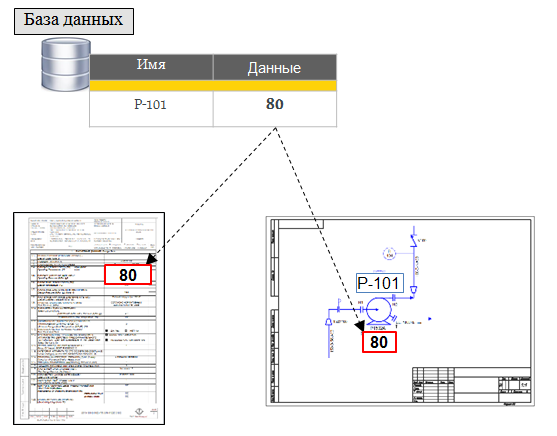
Now we will understand how data is transformed into information for the user.
The data is a collection of different characters and does not in itself carry any meaning. They acquire value only in the context of the problem being solved. At this point, the data and turn into information.
In other words, a document is a data repository. And the user, selecting the data from the document and examining it in a specific context, interprets it and converts it into information.

When a user works with a document, only a certain part of it contains useful data. In the figure, this part is shown as a shaded rectangle.
Information for a specific user is a collection of useful data from all documents and 3D models considered in a specific context.
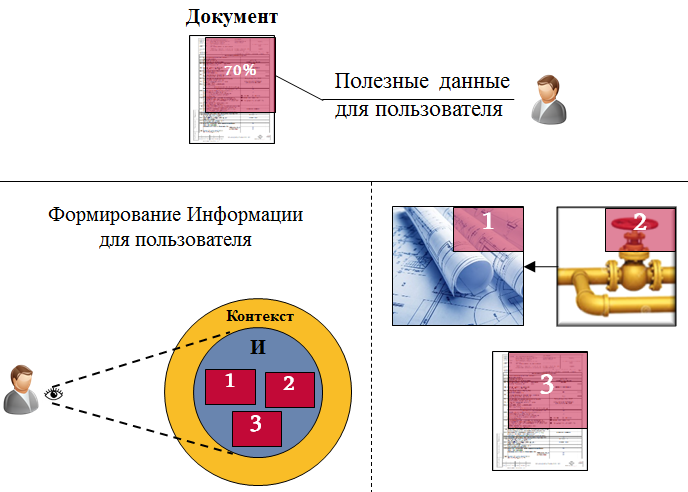
The same set of documents and 3D models contains data that are transformed into different information depending on the users who work with this data, as well as the context for their consideration.

When switching to data-oriented design, the information that is formed by the user remains unchanged. There is only a change in the data source.
Thus, documents are no longer a source of data that is transformed into information for a user. The source becomes a database.

Let us compare the use of two approaches on the example of several of the most frequently encountered data exchange scenarios between participants in the design process.
The first scenario is the joint filling in of a general document. For example, the questionnaire.
In the ATP approach, each participant in the process consistently fills out his part of the document.
With the BEFORE approach, the data for the general document are entered into the database in parallel by all participants, which allows reducing the overall duration of the process.
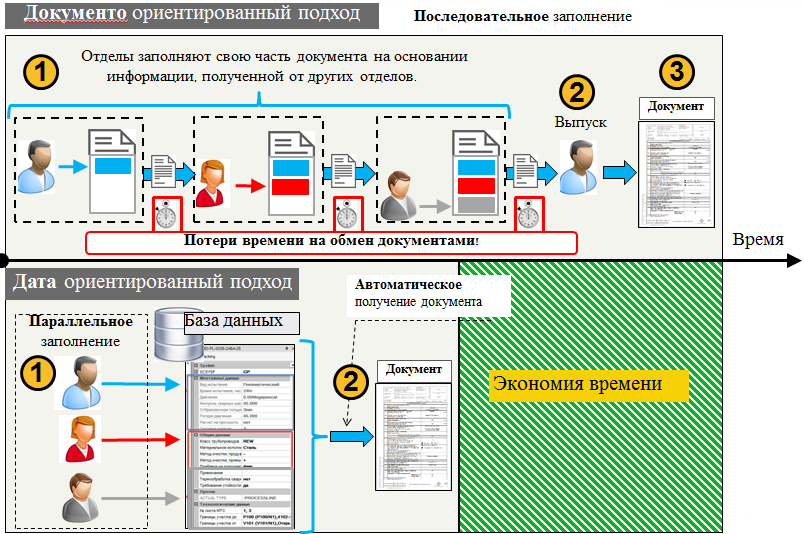
The next scenario is making changes.
In the ATP approach, making changes to one document leads to the need to make changes in dependent documents.
With BEFORE approach, changes are enough to make to the database. Documents will be generated automatically. The entire history of data changes is stored in the database and can be retrieved in case of such necessity.
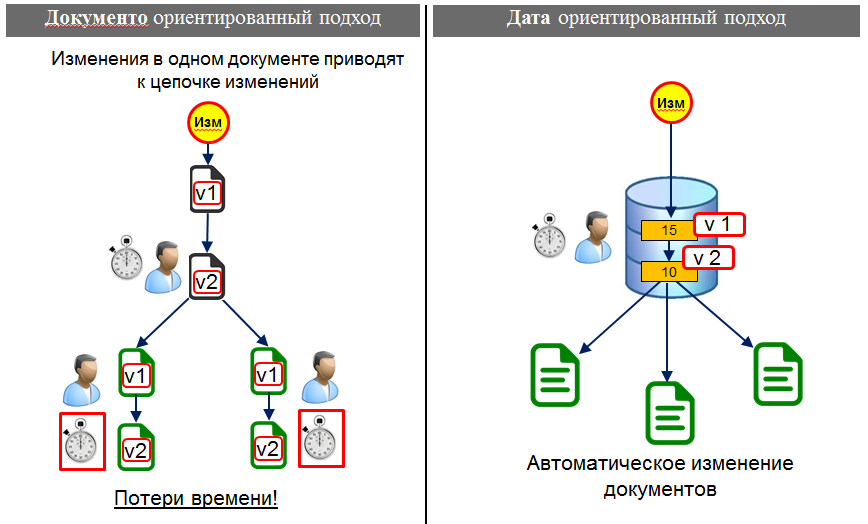
The following scenario is also associated with the change process.
At change of any data it is necessary to carry out the notification of interested persons.
With intensive work and the possible occurrence of various problems with communications, there is a high probability of getting outdated data in the final document.
With BEFORE, data changes only in one place, documents are generated automatically. Therefore, the occurrence of such errors is completely excluded.

Also changing the approach to the exchange of tasks between departments. In the ATP approach, the exchange of tasks is an exchange of documents. In the case of the ATP approach, the exchange of documents disappears. Because all data is stored in a single database, and the level of availability of certain data is regulated by the status system.
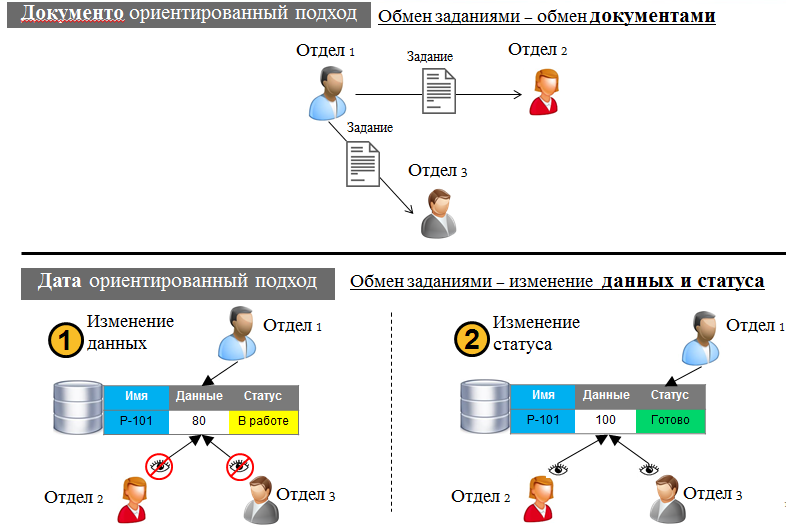
When working with documents, quite often there are situations when different versions of documents are scattered across different local computers of users or network folders. As a result, there is a waste of time searching for the necessary information.
With a BEFORE approach, changes occur at the level of data that is stored in a single database. Therefore, we can quickly access the necessary data and be absolutely sure that this data is relevant.
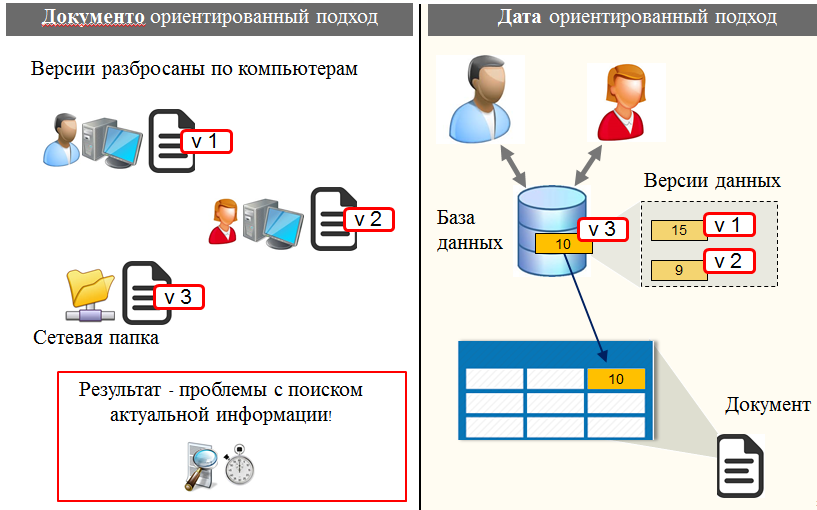
Another simple scenario that reflects the process of transferring a document between users.
In the ATP approach, the first user sends the document to the second user. He, in turn, extracts the necessary data from the document, analyzes them and forms the document for its transfer to other design participants.
When BEFORE the approach, the first user is enough to enter data into the database, and the second user immediately gets access to them. The document itself is then automatically generated, which saves time.
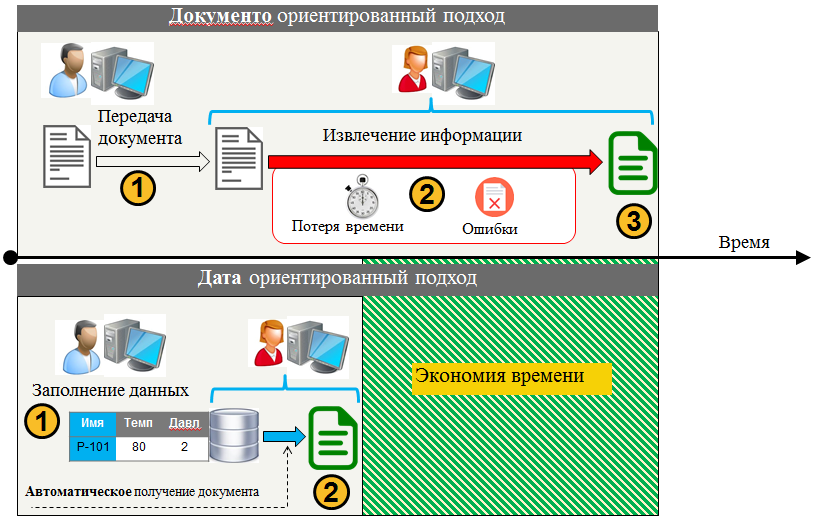
The greatest effect from the application of the DO approach is its sharing with 3D modeling. A very illustrative example is how dramatically the time required to make changes to drawings when using 3D modeling technology. In the classical approach, making changes to the drawings is a fairly time-consuming process, which is fraught with the risk of errors in case of problems with communications within the organization. When using a 3D model and a properly configured tool for automatic generation of drawings, it suffices to make changes only in the 3D model. Drawings will be generated automatically.
Naturally, this is an idealized process and its application is not always possible due to certain requirements for the design of drawings.

Perhaps we’ll dwell on this and think about why, with all the advantages of working with data and 3D models, we are still working with documents.
In my opinion, the main reason is the historically established practice, and the enormous inertia of our system. Please write comments. I am interested in your opinion on this issue.
Introduction
Today, design organizations live in a documented paradigm, and the bulk of the data is stored inside documents.
This is due to the fact that after the completion of the design phase, the release of documentation is still necessary to send it for examination and then to the construction and operation stages. Those. documents are units of information transfer between participants of business processes.
Such an approach was previously only possible. In today's reality, in many areas of life, we are witnessing a transformation and transition from the ATP paradigm to the DO. And this is one of the main directions in the “digital economy” program, the implementation of which will determine the future of our state. In particular, the subsidiary approach is the basis of all modern technologies that define the so-called fourth industrial revolution.
')
In the project activity, however, all information exchange is still fully based on the exchange of documents.
On the other hand, we are witnessing a rather strong interest in information modeling technology (BIM). And although the implementation of this technology differs at the level of various states, industries and individual companies, the basic principles remain common. Among them are the use of 3D models and a common data environment.
But is the implementation of BIM technology possible in the document world?
Let's start with the definitions
Data - the smallest individual entities that are used to describe the objects of the real world. For example, data are object characteristics, such as dimensions or properties of environmental parameters (pressure, temperature, etc.).
Documents are containers for data related to a common context, which depends on the type and purpose of the document. Documents can be submitted both in paper form and in electronic form (pdf, xls, etc.).
The whole point of the transition to the data-oriented approach is to transfer data from the body of the document to the database.

Now we will understand how data is transformed into information for the user.
The data is a collection of different characters and does not in itself carry any meaning. They acquire value only in the context of the problem being solved. At this point, the data and turn into information.
In other words, a document is a data repository. And the user, selecting the data from the document and examining it in a specific context, interprets it and converts it into information.

When a user works with a document, only a certain part of it contains useful data. In the figure, this part is shown as a shaded rectangle.
Information for a specific user is a collection of useful data from all documents and 3D models considered in a specific context.

The same set of documents and 3D models contains data that are transformed into different information depending on the users who work with this data, as well as the context for their consideration.

When switching to data-oriented design, the information that is formed by the user remains unchanged. There is only a change in the data source.
Thus, documents are no longer a source of data that is transformed into information for a user. The source becomes a database.

Let us compare the use of two approaches on the example of several of the most frequently encountered data exchange scenarios between participants in the design process.
The first scenario is the joint filling in of a general document. For example, the questionnaire.
In the ATP approach, each participant in the process consistently fills out his part of the document.
With the BEFORE approach, the data for the general document are entered into the database in parallel by all participants, which allows reducing the overall duration of the process.

The next scenario is making changes.
In the ATP approach, making changes to one document leads to the need to make changes in dependent documents.
With BEFORE approach, changes are enough to make to the database. Documents will be generated automatically. The entire history of data changes is stored in the database and can be retrieved in case of such necessity.

The following scenario is also associated with the change process.
At change of any data it is necessary to carry out the notification of interested persons.
With intensive work and the possible occurrence of various problems with communications, there is a high probability of getting outdated data in the final document.
With BEFORE, data changes only in one place, documents are generated automatically. Therefore, the occurrence of such errors is completely excluded.

Also changing the approach to the exchange of tasks between departments. In the ATP approach, the exchange of tasks is an exchange of documents. In the case of the ATP approach, the exchange of documents disappears. Because all data is stored in a single database, and the level of availability of certain data is regulated by the status system.

When working with documents, quite often there are situations when different versions of documents are scattered across different local computers of users or network folders. As a result, there is a waste of time searching for the necessary information.
With a BEFORE approach, changes occur at the level of data that is stored in a single database. Therefore, we can quickly access the necessary data and be absolutely sure that this data is relevant.

Another simple scenario that reflects the process of transferring a document between users.
In the ATP approach, the first user sends the document to the second user. He, in turn, extracts the necessary data from the document, analyzes them and forms the document for its transfer to other design participants.
When BEFORE the approach, the first user is enough to enter data into the database, and the second user immediately gets access to them. The document itself is then automatically generated, which saves time.

The greatest effect from the application of the DO approach is its sharing with 3D modeling. A very illustrative example is how dramatically the time required to make changes to drawings when using 3D modeling technology. In the classical approach, making changes to the drawings is a fairly time-consuming process, which is fraught with the risk of errors in case of problems with communications within the organization. When using a 3D model and a properly configured tool for automatic generation of drawings, it suffices to make changes only in the 3D model. Drawings will be generated automatically.
Naturally, this is an idealized process and its application is not always possible due to certain requirements for the design of drawings.

Perhaps we’ll dwell on this and think about why, with all the advantages of working with data and 3D models, we are still working with documents.
In my opinion, the main reason is the historically established practice, and the enormous inertia of our system. Please write comments. I am interested in your opinion on this issue.
Source: https://habr.com/ru/post/336940/
All Articles